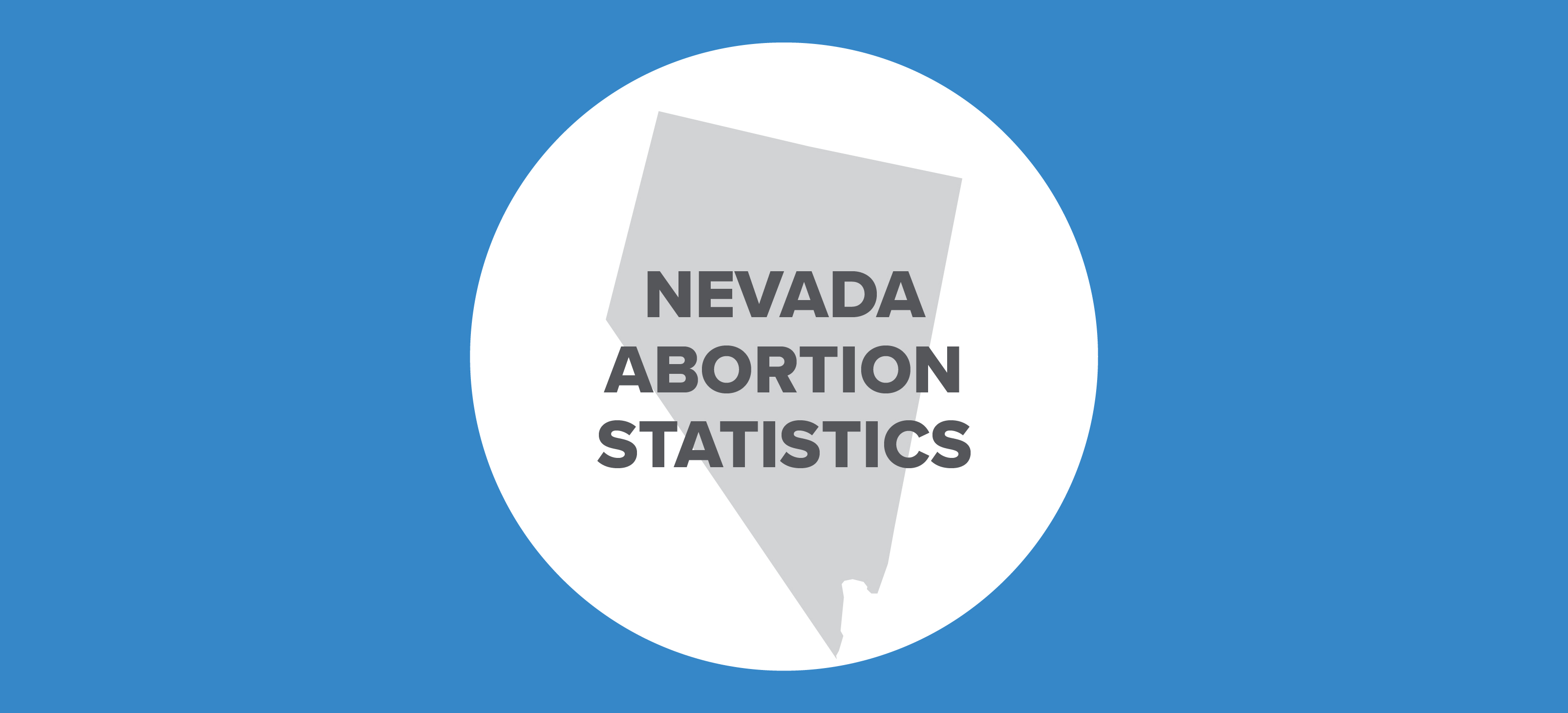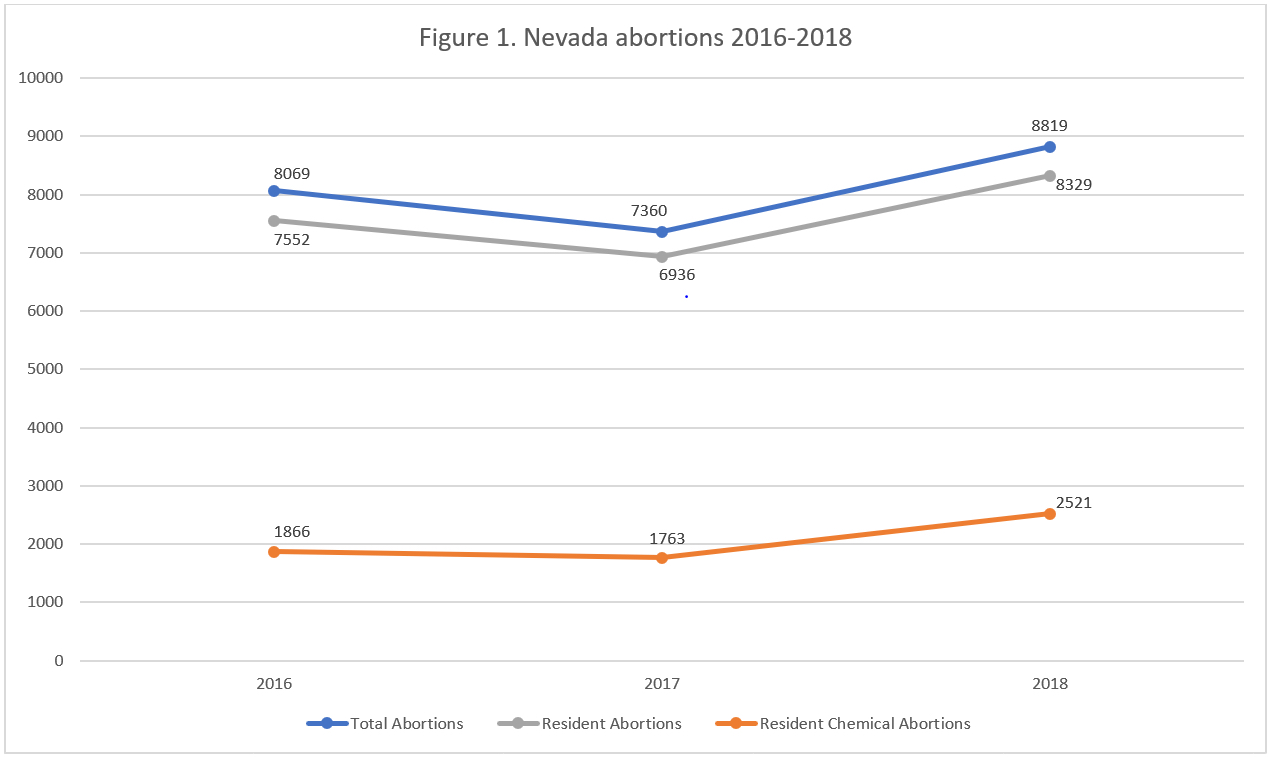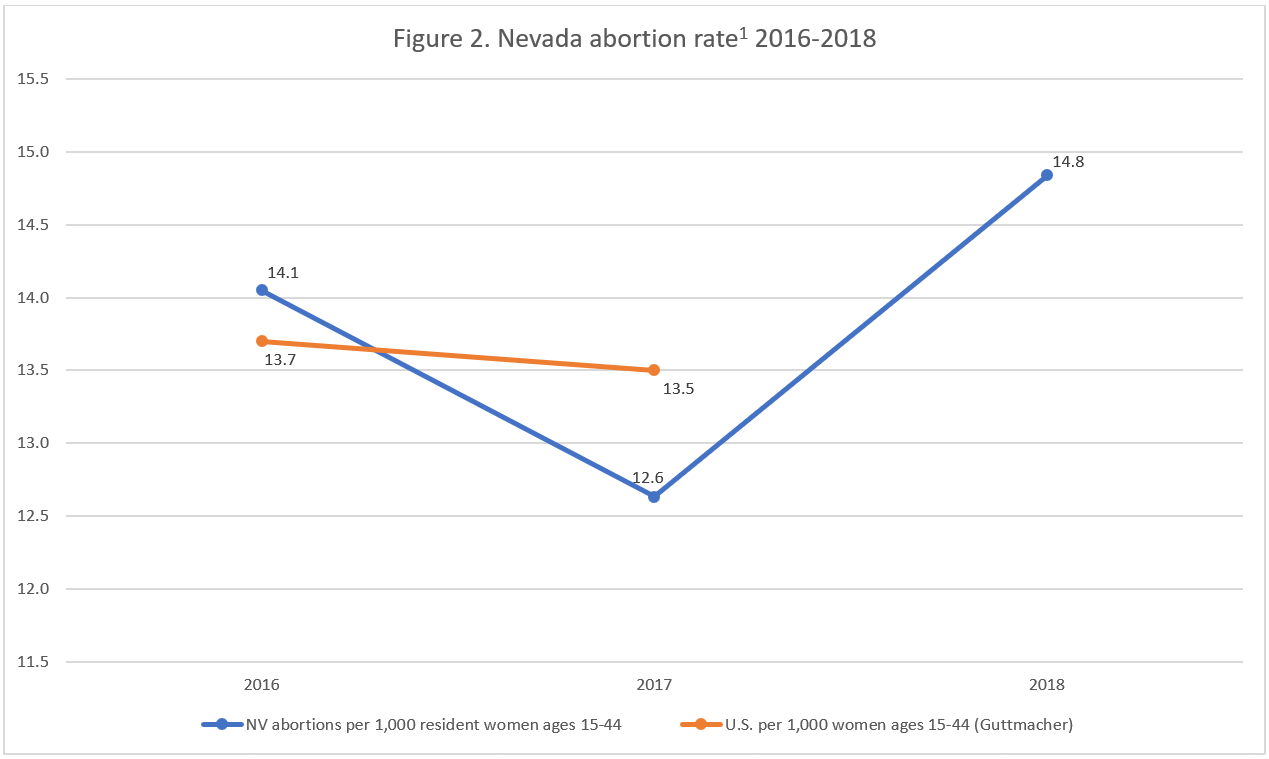Abortion Reporting: Nevada (2018)

Nevada abortion data for 2016, 2017, and 2018 was provided upon request to CLI by the Nevada Department of Health and Human Services. In 2018, abortion totals increased after experiencing a slight dip in 2017.
Changes in Nevada Abortions, 2017-2018

Information on Planned Parenthood’s Nevada market share is not publicly available
Abortion Totals and Trends
In 2018, 8,819 abortions were reported in Nevada. This was an increase of 20 percent from 2017, when 7,360 abortions were reported in the state (Fig. 1). There were 8,329 abortions performed on Nevada residents, up 20 percent from 6,936 the previous year. Of these, 2,521 were chemical abortions, an increase of 43 percent from 2017. Thirty percent of the abortions performed on Nevada residents in 2018 were chemical abortions. The Charlotte Lozier Institute estimates that Nevada’s abortion rate increased from 12.6 abortions per 1,000 women of childbearing age in 2017 to 14.8 in 2018, higher than the national average (Fig. 2).
State Report Summary
In 2018, 94 percent of the abortions reported in Nevada were performed on state residents, while five percent were on nonresidents and not quite half a percent on women of unknown residence. Thirty-eight percent of the abortions occurring in Nevada were performed at six weeks of gestation or earlier. Thirty-two percent occurred between seven and eight weeks and 15 percent between nine and 10 weeks. Six percent of Nevada abortions were performed between 11 and 12 weeks of gestation, dropping to five percent between 13 and 15 weeks and three percent between 16 and 20 weeks. Thirty-nine abortions (0.4 percent) were performed at 21 weeks of gestation or later. Gestational age was not reported for just under one percent of the abortions. In Nevada, abortion is prohibited after 24 weeks of gestation unless the woman’s life or physical or mental health is at risk, an exception that allows for broad justification of late-term abortions.
Most of the information in the report is for abortions performed on resident women only rather than all abortions reported in the state. A majority of the resident women who obtained abortions in Nevada in 2018 were in their twenties (54 percent). Twenty-seven percent were between the ages of 20 and 24, and 28 percent were ages 25 to 29. Thirty-one percent were in their thirties, while eight percent were under the age of 20 and four percent were age 40 or older. Age was unknown for three percent of the resident women who got abortions.
Non-Hispanic white women composed the largest group of resident women undergoing abortions in Nevada (36 percent). Non-Hispanic black women made up 17 percent. Non-Hispanic Asian and Pacific Islander women represented eight percent of the total, and non-Hispanic American Indian and Alaska Native women were 0.5 percent. Thirty-one percent of the women were Hispanic. Four percent were a different race, and another four percent did not have their race reported.
The majority of the resident abortions reported in Nevada, 64 percent, were performed using suction curettage. Thirty percent were chemical abortions, an increase from the previous year, when just 25 percent of the abortions were induced chemically. Three percent were performed via dilation and evacuation. There were two intrauterine instillation procedures, two hysterectomy or hysterotomy abortions, and one sharp curettage abortion. Two percent of the abortions were performed using other methods, and one percent were performed with unknown methods.
Nevada Abortion Law
In July 2019, a new Nevada law removing pro-life protections went into effect. The law weakens Nevada’s informed consent process, removing a requirement that doctors must caution women about the potential physical and emotional impact of abortion and certify the woman’s age. The law also removes sections of Nevada statutes that criminalized the use and sale of abortion drugs and devices by non-physicians, allowing non-physicians to perform abortions and expanding the possibility of chemical abortions outside of a clinical setting. Nevada’s new law will make it easier to distribute the abortion pill without providing women with basic medical examinations or medical care.
State Ranking
In the Charlotte Lozier Institute’s 2016 survey of state abortion reporting, Nevada’s reporting was ranked at 38th. Nevada used to publish abortion data in its annual vital statistics report, but the most recent vital statistics report is for 2004. However, the Nevada Department of Health and Human Services has compiled more recent abortion statistics and provided them to the Charlotte Lozier Institute upon request. Nevada could make abortion data more accessible to residents and researchers by regularly compiling these reports and publishing them online as most other states do.


- Starting with the 2018 abortion reports, abortion rates are calculated by the Charlotte Lozier Institute to allow for easier state-to-state and year-to-year comparisons. Rates were calculated by CLI using population estimates from the United States Census Bureau. The rates were calculated using the following formula: (total number of abortions performed in Nevada ÷ number of resident women ages 15-44) x 1,000. Rates may differ slightly from previous CLI articles due to revised population estimates and abortion totals.























